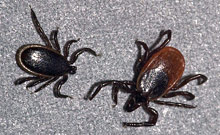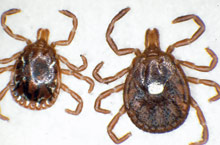- HOME
- » PEST SOLUTIONS
- » Ticks
Ticks
How to deal with ticks
 |
|
Deer ticks (left) and American dog ticks (right). Photo by Jim Occi, BugPics, Bugwood.org. |
 |
|
Deer ticks. Photo by Gary Alpert, Env. Health & Safety, Harvard U. |
 |
|
Lone star ticks. Photo by Mat Pound, USDA Agricultural Research Service, Bugwood.org. |
Take away the spots they're likely to hang—trim shrubs and keep grassy areas mowed. Wear clothes that make it hard for them to get to skin and easy to spot—light-colored clothing and long sleeves; tuck pants into socks at ankles. Check yourself, kids, and pets regularly—especially when you've been out in a meadow or woods.
Got one on you? You want to remove it without squishing it or leaving the head (which will be nestled into the skin) behind. Matches, nail polish, or petroleum jelly could irritate it, increasing the chance it'll transmit disease. Grasp it as close to the skin as possible (tweezers could help) and pull steadily until the little bugger lets go. Then treat the bite with first aid as you would a scratch. If you think the tick fed for more than 24 hours, keep it for ID and possible diagnostic work by putting in the freezer or a small jar with rubbing alcohol.
What they look like
Ticks have eight legs. You'll most likely find them on your family or pets. Around here we've got American dog ticks, brown dog ticks, Lone Star ticks, Ixodes cookei and deer ticks (a.k.a. the blacklegged tick). The ones that blow up to be a gray balloon are dog ticks. Other than that it can be hard to tell without a magnifier. Diagnostic labs can help you ID what kind you've found.
Where they live
Moist areas with long grass, or branches at people- or deer-height. The shrubby boarder between a lawn and the woods is a hot spot. So are meadows.
What they do
Carry well-known diseases—Lyme and Rocky Mountain spotted fever, to name two. But to transmit disease they must attach and feed for many hours. They get on us and other animals by questing—they stand at the tips of grass or ends of branches and wave their little front claws in the air, waiting for something to brush by. Once on a host, they find some skin and start to feed.
Resources
CT Ag Experiment Station's Tick Management Handbook
New York State Department of Health
MA DPH Tickborne Diseases in MA: a physician's reference manual
